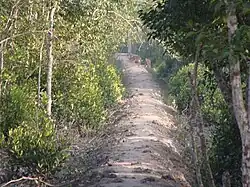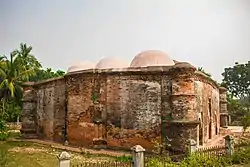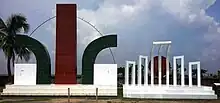Koyra
কয়রা | |
|---|---|
 Mangroves in Sunderbans, Koyra upazila | |
.svg.png.webp) | |
| Coordinates: 22°20.5′N 89°18′E / 22.3417°N 89.300°E | |
| Country | |
| Division | Khulna |
| District | Khulna |
| Thana | 19 November 1979 |
| Upazila | 7 November 1983 |
| Government | |
| • MP (Khulna-6) | Akhteruzzaman Babu |
| • Upazila Chairman | SM Shafiqul Islam |
| Area | |
| • Total | 1,775.40 km2 (685.49 sq mi) |
| Population (1991) | |
| • Total | 165,473 |
| • Density | 93/km2 (240/sq mi) |
| Time zone | UTC+6 (BST) |
| Postal code | 9290 |
| Website | koyra |
Koyra (Bengali: কয়রা) is an upazila of the Khulna District of Bangladesh.[1] It's the 2nd largest Upazila in Bangladesh.
Water bodies Main rivers: dharla, pasur, arpangachhia, Taldhup, Malancha, kobadak, ball; Koyra canal is notable.
History

Koyra's history most likely dates as far back as the office of Khan Jahan Ali in the 15th century at least. This is evident from the ancient mosques found in Koyra such as Masjidkur.
The Channir Chak L.C. Collegiate School was established in 1935. In 1962, the Koyra Madinabad Secondary School was established.

During the Bangladesh Liberation War of 1971, a sub-sector of Sector 9 was founded in Koyra's Amati Union known as Bachharbari-Manoranjan Camp, and so most of the Mukti Bahini's and Mujib Bahini's operations were launched from here. The Bengali freedom fighters built five camps in Koyra; World Poet Camp led by Abd al-Latif, Najmul Camp led by KM Mujibur Rahman, Nazrul Camp led by Abd al-Hakim, Narayan Camp led by Keramat Ali, Shaykh Abd al-Jalil and Shamsur Rahman in Jhileghata and the Suhrawardy Camp led by Rezaul Karim in Bamiya, Bagali Union. In Jaygirmahal, Dr Rafiqul Islam ran a secret medical centre to provide treatment to wounded freedom fighters. A mass grave was found in Launch Ghat, Marighata.
On 19 November 1979, Korya was established as a thana.[2] It was upgraded to an upazila (sub-district) on 7 November 1983.[1]
The Upazila suffered heavy damage following the Cyclone Sidr in 2007 and Cyclone Aila two years after that.
Geography
Koyra is located at 22°20′30″N 89°18′00″E / 22.3417°N 89.3000°E. It has 45,750 households and a total area 1775.40 km2.
Demographics
As of the 2011 Bangladesh census, Koyra upazila had 45,750 households and a population of 193,931. 41,026 (21.15%) were under 10 years of age. Koyra had an average literacy rate of 50.36%, compared to the national average of 51.8%, and a sex ratio of 1033 females per 1000 males. 11,594 (5.98%) of the population lived in urban areas.[3] Ethnic population was 1,243 (0.64%).[4]
The upazila is home to Bengali Muslims primarily as well a very large Bengali Hindu community and the other small ethnic groups such as the Mahato and the Munda people who reside in the Koyra Sadar Union and Uttar Bedkashi Union.[2]
Administration
_-_panoramio.jpg.webp)
Koyra Thana was formed in 1980 and it was turned into an upazila in 1983.Koyra Upazila is divided into seven union parishads: Amadi, Bagali, Dakshin Bedkashi, Koyra, Moharajpur, Moheswaripur Union, and Uttar Bedkashi Union. The union parishads are subdivided into 71 mauzas and 133 villages.[5]
List of chairmen
| Name |
|---|
| Shams ad-Din Ahmad |
| AKM Tamiz ad-Din |
| GM Muhsin Reza |
| Nacher Ali Morol |
| SM Shafiqul Islam |
Facilities
The upazila has three orphanages: Haji Rahim Orphanage, Qadi Kabir ad-Din Orphanage and Haji Qamar ad-Din Orphanage.
Notable people
- Ruman Shana, archer
- Shah Md. Ruhul Quddus, politician
See also
References
- 1 2 Md Ashraful Islam Goldar (2012). "Koyra Upazila". In Sirajul Islam; Miah, Sajahan; Khanam, Mahfuza; Ahmed, Sabbir (eds.). Banglapedia: the National Encyclopedia of Bangladesh (Online ed.). Dhaka, Bangladesh: Banglapedia Trust, Asiatic Society of Bangladesh. ISBN 984-32-0576-6. OCLC 52727562. OL 30677644M. Retrieved 27 December 2023.
- 1 2 এক নজরে কয়রা [Koyra at a glance]. Koyra Upazila (in Bengali).
- 1 2 "Bangladesh Population and Housing Census 2011 Zila Report – Khulna" (PDF). bbs.gov.bd. Bangladesh Bureau of Statistics.
- ↑ "Community Tables: Khulna district" (PDF). bbs.gov.bd. Bangladesh Bureau of Statistics. 2011.
- ↑ "District Statistics 2011: Khulna" (PDF). Bangladesh Bureau of Statistics. Archived from the original (PDF) on 13 November 2014. Retrieved 2 February 2022.
